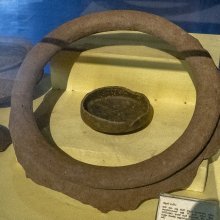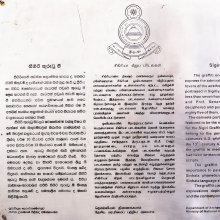Mita, Miṭā, Miṭa, Mitā: 22 definitions
Introduction:
Mita means something in Buddhism, Pali, Hinduism, Sanskrit, the history of ancient India, Marathi, Hindi, Tamil. If you want to know the exact meaning, history, etymology or English translation of this term then check out the descriptions on this page. Add your comment or reference to a book if you want to contribute to this summary article.
Alternative spellings of this word include Meet.
Images (photo gallery)
(+4 more images available)
In Hinduism
Purana and Itihasa (epic history)
Source: archive.org: Shiva Purana - English TranslationMita (मित) refers to “(that which is) limited” (as opposed to Amita—‘unlimited’), according to the Śivapurāṇa 2.3.54 (“Description of the duties of the chaste wife”).—Accordingly, as a Brahmin lady said to Pārvatī: “[...] What father gives is limited (mita), what brother gives is limited (mita) and what the son gives is also limited (mita). A chaste lady shall worship her husband who gives what has no limit. To a wife the husband is god, preceptor, virtue, holy centre and sacred rite. She should cast off everything and adore him alone. [...]”.
Source: Cologne Digital Sanskrit Dictionaries: The Purana Index1a) Mita (मित).—A Marut of the 5th gaṇa.*
- * Brahmāṇḍa-purāṇa III. 5. 96.
1b) A Sudharmāṇa god.*
- * Brahmāṇḍa-purāṇa IV. 1. 60.

The Purana (पुराण, purāṇas) refers to Sanskrit literature preserving ancient India’s vast cultural history, including historical legends, religious ceremonies, various arts and sciences. The eighteen mahapuranas total over 400,000 shlokas (metrical couplets) and date to at least several centuries BCE.
Shaivism (Shaiva philosophy)
Source: ORA: Amanaska (king of all yogas): (Shaivism)Mita (मित) refers to “limited (understanding)”.—In his commentary to the Svacchandatantra (11.197), Kṣemarāja provides the following definition: “Kuhaka is that which causes astonishment and convinces those of limited understanding (mita-hṛdaya). It is chiefly magic”. In his commentary on the Netratantra (18.89), Kṣemarāja glosses kuhakāni as: “Deceitful (things) such as amulets of control, witches, etc.”. These glosses affirm that kuhaka can be understood more specifically to mean an astonishing, magical feat rather than its general sense of something that causes astonishment, the latter definition being that of Dhātupāṭha 10.443.

Shaiva (शैव, śaiva) or Shaivism (śaivism) represents a tradition of Hinduism worshiping Shiva as the supreme being. Closely related to Shaktism, Shaiva literature includes a range of scriptures, including Tantras, while the root of this tradition may be traced back to the ancient Vedas.
In Buddhism
Theravada (major branch of Buddhism)
Source: Pali Kanon: Pali Proper NamesA stronghold in Ceylon, mentioned in the account of the campaigns of Parakkamabahu I. Cv.lxx.134.
Theravāda is a major branch of Buddhism having the the Pali canon (tipitaka) as their canonical literature, which includes the vinaya-pitaka (monastic rules), the sutta-pitaka (Buddhist sermons) and the abhidhamma-pitaka (philosophy and psychology).
Mahayana (major branch of Buddhism)
Source: Wisdom Library: Maha Prajnaparamita SastraMita (मित) refers to “limited (domain)”, according to the 2nd century Mahāprajñāpāramitāśāstra chapter 40.—Accordingly: [...] Moreover, the Wheel of the Dharma has great superiority over the jewel of the wheel. [...] The jewel of the wheel is connected to the happiness resulting from the five objects of enjoyment; the Wheel of the Dharma is connected to the happiness of the Dharma. The jewel of the wheel is a basis for fetters; the Wheel of the Dharma is not a basis for fetters. The jewel of the wheel has a limited domain (mita-gocara); the Wheel of the Dharma has an unlimited domain. [...]

Mahayana (महायान, mahāyāna) is a major branch of Buddhism focusing on the path of a Bodhisattva (spiritual aspirants/ enlightened beings). Extant literature is vast and primarely composed in the Sanskrit language. There are many sūtras of which some of the earliest are the various Prajñāpāramitā sūtras.
India history and geography
Source: archive.org: Ceylon Branch of the Royal Asiatic Society 1963Mita is the name of a locality that existed in the ancient kingdom of Anurādhapura, Ceylon (Sri Lanka).—To oppose Parakkamabāhu’s forces who crossed the Kalā Oya and took up position at Aṅgamu (see above), Gajabāhu's troops engaged them at Senāgāma but were defeated. Parakkamabāhu's troops then continued their advance towards Anurādhapura and successively captured:—(i) Manyāgāma; (ii) Mita; (iii) Sūkaragāma; (iv) Terigāma (see Teragama); and (v) Badarībhātikamāna, a few miles from Anurādhapura.

The history of India traces the identification of countries, villages, towns and other regions of India, as well as mythology, zoology, royal dynasties, rulers, tribes, local festivities and traditions and regional languages. Ancient India enjoyed religious freedom and encourages the path of Dharma, a concept common to Buddhism, Hinduism, and Jainism.
Languages of India and abroad
Pali-English dictionary
Source: BuddhaSasana: Concise Pali-English Dictionarymita : (pp. of miṇāti) measured; weighed; balanced.
Source: Sutta: The Pali Text Society's Pali-English DictionaryMita, (Vedic mita, pp. of mā, mināti, to measure; also in meaning “moderate, measured, ” cp. in same sense Gr. mέtrios) measured, in measure D. I, 54 (doṇa° a doṇa measure full); Sn. 300 (bhāgaso m. measured in harmonious proportions, i.e. stately); Pv. I, 1013 (id.); J. III, 541.—amita unlimited, without measure, boundless, in Ep. amit-ābha of boundless lustre Sdhp. 255. Also N. of a Buddha.

Pali is the language of the Tipiṭaka, which is the sacred canon of Theravāda Buddhism and contains much of the Buddha’s speech. Closeley related to Sanskrit, both languages are used interchangeably between religions.
Marathi-English dictionary
Source: DDSA: The Molesworth Marathi and English Dictionarymita (मित).—p (S) Measured. 2 fig. Moderate, temperate, of the due quantity or degree. Ex. of comp. mitabhāṣaṇa, mitabhōjana, mitāśana, mitabhōjī, mitabhāṣī, mitāhāra, mitavyaya, mitavyayī.
--- OR ---
mīṭa (मीट).—f(miṭaṇēṃ) Glued and closed state (of the eyes) through excess of the gummy excretion: closedness generally (of eyes, flowers, leaves,
Source: DDSA: The Aryabhusan school dictionary, Marathi-Englishmita (मित).—p Measured. Fig. Moderate.
--- OR ---
mīṭa (मीट).—f Closedness (of eye &c.).
Marathi is an Indo-European language having over 70 million native speakers people in (predominantly) Maharashtra India. Marathi, like many other Indo-Aryan languages, evolved from early forms of Prakrit, which itself is a subset of Sanskrit, one of the most ancient languages of the world.
Sanskrit dictionary
Source: DDSA: The practical Sanskrit-English dictionaryMita (मित).—p. p. [mi mā-vā-kta]
1) Measured, meted or measured out.
2) Measured off, bounded, defined.
3) Limited, measured, moderate, little, scanty, sparing, brief (words &c); पृष्टः सत्यं मितं ब्रूते स भृत्योऽर्हो महीभुजाम् (pṛṣṭaḥ satyaṃ mitaṃ brūte sa bhṛtyo'rho mahībhujām) Pañcatantra (Bombay) 1.87; R.9.34.
4) Measuring, of the measure of (at the end of comp.), as in ग्रहवसुकरिचन्द्रमिते वर्षे (grahavasukaricandramite varṣe) i. e. in 1889.
5) Investigated, examined.
6) Cast, thrown away.
7) Built.
8) Established, founded.
Source: Cologne Digital Sanskrit Dictionaries: Edgerton Buddhist Hybrid Sanskrit DictionaryMīṭa (मीट) or Mīḍa.—(m.), = next, dung: mīṭa-sthāne yathā krimiḥ Śikṣāsamuccaya 81.4; (varāha) iva mīḍa-kuṇape (compare [Boehtlingk and Roth] 5.1302 s.v. kuṇapa) Kāśyapa Parivarta 101.5; satkāra-mīḍe pata- naṃ Kāśyapa Parivarta 131.8 (verse; in 3 above, satkāra-uccāra-patanaṃ).
Source: Cologne Digital Sanskrit Dictionaries: Shabda-Sagara Sanskrit-English DictionaryMita (मित).—mfn.
(-taḥ-tā-taṃ) 1. Measured. 2. Moderate, limited, few or little. 3. Known, understood. 4. Examined. 5. Scattered, sprinkled. E. mā to mete, or mi to scatter, aff. kta, form irr.
Source: Cologne Digital Sanskrit Dictionaries: Cappeller Sanskrit-English DictionaryMita (मित).—1. [adjective] measured, defined, limited; scanty, succinct, small, concise; examined, known.
--- OR ---
Mita (मित).—2. [adjective] fixed, firm, solid.
Source: Cologne Digital Sanskrit Dictionaries: Monier-Williams Sanskrit-English Dictionary1) Mita (मित):—[from mi] 1. mita mfn. (for 2. See below) fixed, set up, founded, established, [Ṛg-veda; Atharva-veda; Śāṅkhāyana-śrauta-sūtra]
2) [v.s. ...] firm, strong (See [compound])
3) [v.s. ...] cast, thrown, scattered, [Horace H. Wilson]
4) 2. mita mfn. (√3. mā; for 1. mita See √1. mi) measured, meted out, measured or limited by id est. equal to ([instrumental case] or [compound]), [Sūryasiddhānta; Varāha-mihira’s Bṛhat-saṃhitā; Bhāgavata-purāṇa]
5) containing a [particular] measure id est. measuring, consisting of ([accusative]), [Ṛgveda-prātiśākhya]
6) [Bhartṛhari] ([varia lectio])
7) measured, moderate, scanty, frugal, little, short, brief, [Inscriptions; Manu-smṛti; Kāvya literature] etc.
8) measured id est. investigated, known (See loka)
9) m. Name of a divine being (associated with Sammita), [Yājñavalkya]
10) of a Ṛṣi in the third Manv-antara, [Viṣṇu-purāṇa]
11) Mīta (मीत):—[from mī] See under pra-√mī.
Source: Cologne Digital Sanskrit Dictionaries: Yates Sanskrit-English DictionaryMita (मित):—[(taḥ-tā-taṃ) a.] Measured; known; moderate; sprinkled.
Source: DDSA: Paia-sadda-mahannavo; a comprehensive Prakrit Hindi dictionary (S)Mita (मित) in the Sanskrit language is related to the Prakrit word: Mia.
[Sanskrit to German]
Sanskrit, also spelled संस्कृतम् (saṃskṛtam), is an ancient language of India commonly seen as the grandmother of the Indo-European language family (even English!). Closely allied with Prakrit and Pali, Sanskrit is more exhaustive in both grammar and terms and has the most extensive collection of literature in the world, greatly surpassing its sister-languages Greek and Latin.
Hindi dictionary
Source: DDSA: A practical Hindi-English dictionary1) Mita (मित) [Also spelled mit]:—(a) moderate, temperate; restricted; frugal; ~[bhāṣaṇa] temperance in speech; reticence; ~[bhāṣī] temperate in speech; reticent; ~[pāna] temperance in drink; ~[bhojana] temperance in food; ~[bhojī] eating a small quantity; ~[mati] a nitwit, stupid; ~[vyaya] thrift, frugality; ~[vyayitā] thriftiness, frugality, ~[vyayī] thrifty, frugal.
2) Mīta (मीत) [Also spelled meet]:—(nm) a friend.
...
Kannada-English dictionary
Source: Alar: Kannada-English corpusMita (ಮಿತ):—[adjective] ceased to exist; dead.
--- OR ---
Mita (ಮಿತ):—
1) [adjective] measured; weighed.
2) [adjective] confined with bounds; restricted within a set boundaries; not free; limited.
3) [adjective] brief; short; little.
4) [adjective] restricted by rules, regulations.
5) [adjective] thinly spread or distributed; not abundantly available.
6) [adjective] checked; tested; examind.
--- OR ---
Mita (ಮಿತ):—
1) [noun] the act of measuring, weighing, etc.
2) [noun] that which is limited, restricted.
Kannada is a Dravidian language (as opposed to the Indo-European language family) mainly spoken in the southwestern region of India.
Tamil dictionary
Source: DDSA: University of Madras: Tamil LexiconMiṭā (மிடா) noun perhaps from மடு-. [madu-.] [Malayalam: miḍavu.]
1. Large earthen vessel; தடா. சோறு செப்பி னாயிரம் மிடா [thada. soru seppi nayiram mida] (சீவகசிந்தாமணி [sivagasindamani] 692). (பிங்கலகண்டு [pingalagandu])
2. Pot; பானை. (பிங்கலகண்டு) [panai. (pingalagandu)]
--- OR ---
Mita (மித) [mitattal] 12 intransitive verb
1. To float; நீர் முதலியவற்றின்மேல் கிடத்தல். சுரையாழ வம்மி மிதப்ப [nir muthaliyavarrinmel kidathal. suraiyazha vammi mithappa] (நன். [nan.] 152, விருத். [viruth.]).
2. To rise high in the sky; மேலெழும்புதல். [melezhumbuthal.] (W.)
3. To be heaped in a measure, as corn; அளவில் மேற்குவி தல். மிதக்க அள. [alavil merkuvi thal. mithakka ala.]
4. To be abundant; to be in excess; மிகுதல். வெம்புநீர் மிதப்ப மாந்தி [miguthal. vembunir mithappa manthi] (விநாயகபு. [vinayagapu.] 74, 226).
5. To assume, to pretend to a character above the reality; வீண்பெருமை பண்ணுதல். [vinperumai pannuthal.] (W.)
Tamil is an ancient language of India from the Dravidian family spoken by roughly 250 million people mainly in southern India and Sri Lanka.
See also (Relevant definitions)
Starts with (+88): Mita patish, Mita zerah, Mita-bala, Mita-bolai, Mita-buhari, Mita-choro, Mita-lagai, Mita-lagaunu, Mita-masala, Mitabhani, Mitabhanin, Mitabhashe, Mitabhashi, Mitabhashin, Mitabhashini, Mitabhashininiruktiprakasha, Mitabhashita, Mitabhashitar, Mitabhashitri, Mitabhashitva.
Ends with (+363): Abhinamita, Abhinimmita, Abhinirmita, Abhiramita, Abhisamita, Abhyamita, Abhyastamita, Abhyupagamita, Abhyupamita, Adhiniyamita, Adhumita, Agamita, Ajamita, Ajihmita, Akramita, Akusumita, Amita, Amtarnirmita, Anagamita, Anakramita.
Full-text (+299): Mithas, Mitha, Mitabhuj, Spridhya, Mitho, Mitashana, Mia, Amita, Mitadru, Mitavac, Mitam, Mithasa, Mitahara, Samitam, Amitam, Mitampaca, Mitajnu, Sammitam, Pramita, Mitaravin.
Relevant text
Search found 33 books and stories containing Mita, Miṭā, Miṭa, Mitā, Mīṭa, Mīta, Mitha, Mida, Midha, Midaa; (plurals include: Mitas, Miṭās, Miṭas, Mitās, Mīṭas, Mītas, Mithas, Midas, Midhas, Midaas). You can also click to the full overview containing English textual excerpts. Below are direct links for the most relevant articles:
Chaitanya Bhagavata (by Bhumipati Dāsa)
Verse 3.3.84 < [Chapter 3 - Mahāprabhu’s Deliverance of Sarvabhauma, Exhibition of His Six-armed Form, and Journey to Bengal]
Verse 3.4.328 < [Chapter 4 - Descriptions of Śrī Acyutānanda’s Pastimes and the Worship of Śrī Mādhavendra]
Verse 3.3.233 < [Chapter 3 - Mahāprabhu’s Deliverance of Sarvabhauma, Exhibition of His Six-armed Form, and Journey to Bengal]
Rig Veda (translation and commentary) (by H. H. Wilson)
Bhajana-Rahasya (by Srila Bhaktivinoda Thakura Mahasaya)
Text 12 < [Chapter 6 - Ṣaṣṭha-yāma-sādhana (Sāyaṃ-kālīya-bhajana–bhāva)]
Text 36 < [Chapter 1 - Prathama-yāma-sādhana (Niśānta-bhajana–śraddhā)]
Far from Home < [July 1952]
Triple Stream < [April – June, 2006]
Our Contributors < [January – March, 1994]
Manusmriti with the Commentary of Medhatithi (by Ganganatha Jha)
Verse 8.195 < [Section XXXII - Deposits (nikṣepa)]
Verse 11.109 < [Section XI - Expiation of “Minor Offences”: Cow-killing (goghna)]





